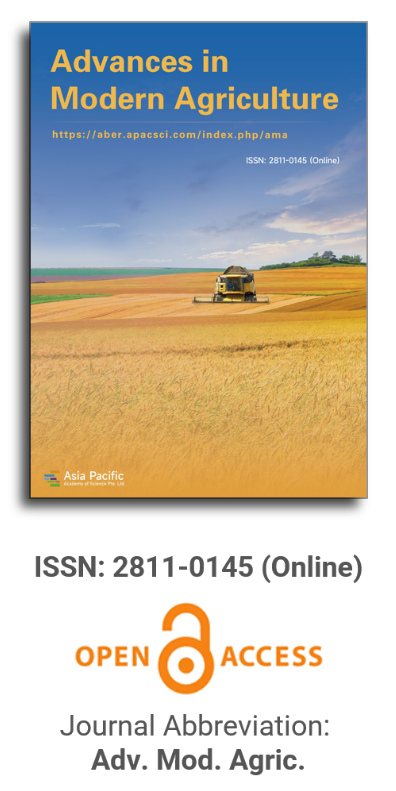


A new approach to measure spatial variability of soil parameters and field technique to test-value specific fertilizer recommendations
Vol 5, Issue 1, 2024
VIEWS - 4902 (Abstract)
Download PDF
Abstract
Information on the distribution of soil properties is important to know the status of nutrients in the soils based on which fertilizer nutrients are recommended. Given the variability of nutrients in the soils, making a site-specific fertilizer recommendation seems to be a compelling work. To determine the spatial variability of soil nutrients and to make judicious and precise fertilizer recommendations, new measures are designed with this study. These measures are tested against the soil samples (n = 43) for total nitrogen (N), organic matter (OM), phosphorus (P2O5), and potassium (K2O) in the study area. The descriptive statistical analysis indicated an average of low nitrogen and organic matter, while phosphorus was found to be very high and the level of potassium was high. The spread of nutrients across the data sets, however, included low, medium, high, and very high levels of ratings. The Deviation Square Index was developed and applied for the variability measurement and found that the largest variation was with phosphorus distribution, followed by potassium, nitrogen, and organic matter. The coefficient of variation (CV%) analysis also exhibited similar trends in nutrient distributions. Nitrogen was the main determinant explaining the variations in rice yield, while phosphorus and potash were negatively related to the yield. An index of fertilizer nutrient recommendation called Test-Value Specific Dose (TVSD) was developed and used to calculate the nutrient recommendation for each sampled location. This new method gave easy and more accurate doses of fertilizer over the blanket recommendation to fit the variations across the soil samples.
Keywords
References
- Soropa G, Mbisva OM, Nyamangara J, et al. Spatial variability and mapping of soil fertility status in a high-potential smallholder farming area under sub-humid conditions in Zimbabwe. SN Applied Sciences. 2021, 3(4). doi: 10.1007/s42452-021-04367-0
- Reza SK, Ray P, Ramachandran S, et al. Spatial Distribution of Soil Nitrogen, Phosphorus and Potassium Contents and Stocks in Humid Subtropical North-Eastern India. Journal of the Indian Society of Soil Science. 2019, 67(1): 12. doi: 10.5958/0974-0228.2019.00002.1
- Ramzan S, Wani MA, Bhat MA. Assessment of Spatial Variability of Soil Fertility Parameters Using Geospatial Techniques in Temperate Himalayas. International Journal of Geosciences. 2017, 08(10): 1251-1263. doi: 10.4236/ijg.2017.810072
- Yan P, Peng H, Yan L, et al. Spatial Variability of Soil Physical Properties Based on GIS and Geo-Statistical Methods in the Red Beds of the Nanxiong Basin, China. Polish Journal of Environmental Studies. 2019, 28(4): 2961-2972. doi: 10.15244/pjoes/92245
- Zakaria Y, Shaibu AG, Baatuuwie B. Spatial analysis of soil physicochemical and hydraulic properties in the Libga irrigation scheme in northern Ghana using geostatistics and GIS approach. Soil Science Annual. 2022, 73(2): 1-8. doi: 10.37501/soilsa/149942
- Ackerson JP. Soil Sampling Guidelines. Purdue University Extension; 2018.
- UVM. Nutrient Recommendations for Field Crops in Vermont. The University of Vermont; 2018.
- Warncke D, Dahl J, Jacobs L. Nutrient Recommendations for Field Crops in Michigan. Michigan State University; 2009
- Nathan MV. Soils, Plant Nutrition and Nutrient Management. Extension, University of Missouri; 2017.
- International Fertilizer Development Center. Nepal launches site-specific fertilizer recommendations for rice. Available online: https://ifdc.org/2022/07/25/Nepal-launches-site-specific-fertilizer-recommendations-for-rice/ (accessed on 2 June 2023).
- Bana RC, Yadav SS, Shivran AC, et al. Site-specific Nutrient Management for Enhancing Crop Productivity. International Research Journal of Pure and Applied Chemistry. 2020, 21(15): 17-25. doi: 10.9734/irjpac/2020/v21i1530249
- Buresh RJ. Site-specific nutrient management in rice. In: Proceedings of the International Potash Institute (IPI), and World Phosphate Institute (IMPHOS); 8 February 2007; Sharm El-Sheik, Egypt.
- Havlin JL, Tisdale SL, Nelson WL, Beaton JD. Soil Fertility and Fertilizers an introduction to Nutrient Management, 8th ed. Pearson India Education; 2017.
- Dinkins CP, Jones C. Interpretation of Soil Test Reports for Agriculture, Extension. Montana State University; 2013.
- Pandit NR, Choudhary D, Maharjan S, et al. Optimum Rate and Deep Placement of Nitrogen Fertilizer Improves Nitrogen Use Efficiency and Tomato Yield in Nepal. Soil Systems. 2022, 6(3): 72. doi: 10.3390/soilsystems6030072
- Rawal N, Pande KR, Shrestha R, et al. Soil Nutrient Balance and Soil Fertility Status under the Influence of Fertilization in Maize-Wheat Cropping System in Nepal. Applied and Environmental Soil Science. 2022, 2022: 1-11. doi: 10.1155/2022/2607468
- Soil Management Directorate. Annual Report 2013–2014. Soil Management Directorate, Department of Agriculture, Hariharbhawan; 2014.
- Tandan RP, Rai R, Basnet L, Karki KB. Soil nutrition distribution in Eastern Tarai of Nepal: A case study of Jhorahat VDC of Morang District. In: Proceedings of the Second National Soil Fertility Research Workshop; 24–25 March 2015; Kathmandu, Nepal.
- Grzyb A, Wolna-Maruwka A, Niewiadomska A. Environmental Factors Affecting the Mineralization of Crop Residues. Agronomy. 2020, 10(12): 1951. doi: 10.3390/agronomy10121951
- Dahal H. Research Perspective on Nutrient Management and Sustainability of Agriculture. Online Published Book; 2021.
- Verma VK, Patel LB, Toor GS, Sharma PK. Spatial distribution of macronutrients in soils of arid tract of Punjab, India. International Journal of Agriculture and Biology. 2005, 7(2).
- Tiwari KR. Soil types and fertility status in Western Terai Region of Nepal: A case from the Bankatawa VDC of the Banke District. In: Proceedings of the Second National Soil Fertality Research Workshop; 24–25 March 2015; Lalitpur, Nepal.
- Schmidt O, Hughes-Games G. Potassium Considerations for Nutrient Management. Nutrient Management Factsheet No 7. Ministry of Agriculture and Lands; 2010.
- Qureshi A, Singh DK, Pandey PC, et al. Site specific nutrient management approach for enhancing productivity and profitability in rice and wheat under rice-wheat cropping system. International Journal of Agricultural Sciences. 2016, 8(54): 2838–2842.
- Verma P, Chauhan A, Ladon T. Site specific nutrient management: A review. Journal of Pharmacognosy and Phytochemistry. 2020, 9(5): 233–236.
- Chivenge P, Zingore S, Ezui KS, et al. Progress in research on site-specific nutrient management for smallholder farmers in sub-Saharan Africa. Field Crops Research. 2022, 281: 108503. doi: 10.1016/j.fcr.2022.108503
- Richards MB, Bahl KB, Jat ML, et al. Site Specific Nutrient Management: Implementation Guidance for Policy Makers and Investors. Global Alliance for Climate Smart Agriculture; 2015.
- Cotteni A. Soil and Plant Testing as A Basis of Fertilizer Recommendations. FAO Soil Bulletin 38/2; 1980.
- Sanchez PA. Properties and Management of Soils in the Tropics. John Wily and Sons; 1976.
- Pierce FJ, Robert PC, Mangold G. Site specific management: The pros, the cons, and the realities. Available online: https://dr.lib.iastate.edu/server/api/core/bitstreams/353dabfa-f415-44c5-8049-37787740fc15/content (accessed on 20 February 2024).
- Sida TS, Gameda S, Chamberlin J, et al. Failure to scale in digital agronomy: An analysis of site-specific nutrient management decision-support tools in developing countries. Computers and Electronics in Agriculture. 2023, 212: 108060. doi: 10.1016/j.compag.2023.108060
- Betteridge K, Schnug E, Haneklaus. Will site specific nutrient management live up to expectation? Agriculture and Forestry Research. 2008, 2008(58): 283-294.
Supporting Agencies
Copyright (c) 2024 Hari Dahal

This work is licensed under a Creative Commons Attribution 4.0 International License.

This site is licensed under a Creative Commons Attribution 4.0 International License (CC BY 4.0).

Prof. Zhengjun Qiu
Zhejiang University, China

Cheng Sun
Academician of World Academy of Productivity Science; Executive Chairman, World Confederation of Productivity Science China Chapter, China
Indexing & Archiving
In the realm of modern agriculture, the integration of cutting-edge technologies is revolutionizing the way we approach sustainable farming practices. A recent study published in Advances in Modern Agriculture titled "Classification of cotton water stress using convolutional neural networks and UAV-based RGB imagery" has garnered significant attention for its innovative approach to precision irrigation management. Conducted by researchers from Institute of Data Science and the AgriLife Research and Extension Center of Texas A&M University (authors's information is below). This study introduces a novel method for classifying cotton water stress using unmanned aerial vehicles (UAVs) and convolutional neural networks (CNNs), offering a powerful solution for optimizing water use in agriculture.
Modern agricultural technology is evolving rapidly, with scientists collaborating with leading agricultural enterprises to develop intelligent management practices. These practices utilize advanced systems that provide tailored fertilization and treatment options for large-scale land management.
This journal values human initiative and intelligence, and the employment of AI technologies to write papers that replace the human mind is expressly prohibited. When there is a suspicious submission that uses AI tools to quickly piece together and generate research results, the editorial board of the journal will reject the article, and all journals under the publisher's umbrella will prohibit all authors from submitting their articles.
Readers and authors are asked to exercise caution and strictly adhere to the journal's policy regarding the usage of Artificial Intelligence Generated Content (AIGC) tools.
Asia Pacific Academy of Science Pte. Ltd. (APACSCI) specializes in international journal publishing. APACSCI adopts the open access publishing model and provides an important communication bridge for academic groups whose interest fields include engineering, technology, medicine, computer, mathematics, agriculture and forestry, and environment.



.jpg)
.jpg)

.jpg)
